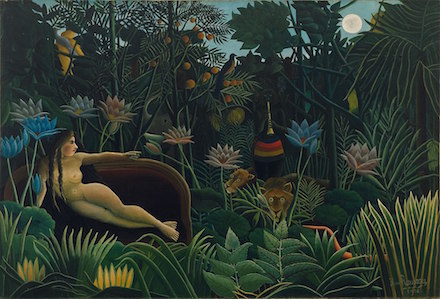
|
|
|
|
|
MacQueen’s Quinterly: Knock-your-socks-off Art and Literature
| Issue 25: | 22 Sept. 2024 |
| Poem: | 209 words |
By Robbi Nester
What He Collected
—After The Dream by Henri Rousseau
In his job as customs man, Rousseau appraised curiosities from everywhere, learning in the process about cultures he never otherwise experienced. Except in the halls of a museum, he had not explored the ruins of the ancient world or trekked a jungle, yet he absorbed these wonders from the pages of encyclopedias, studied all the shades and shapes of green in botanical gardens, observed exotic beasts behind the bars of cages at the zoo. He made note of all this in his paintings, where ancient Egyptian lotuses rise like fans over a European odalisque, with her companion brace of lionesses, diminutive shy elephant, a world lit from within by imagination’s light. The eye follows the divan’s curved line, hand extended to the crouched lions, angled end of a snake, all in the same sinuous curve. Bright fruit hangs overhead. The woman is at once Eve and the Egyptian goddess Hathor—consort of the Sun God—muse, creator, and destroyer, bridge to other worlds. She’s a hieroglyph, encoding whole cosmologies, aesthetics. In the center of the frame, yet still somehow invisible, a green-faced guard fades into leafy shadows, serenades her in this monument to colonial collections with a kind of flute.

The Dream (Le Rêve), 1910
This oil-on-canvas painting by French post-Impressionist painter Henri Rousseau (1844-1910) was his last completed work and is held at the Museum of Modern Art in New York. The reproduction above was downloaded from the public domain via Wikimedia Commons.
| Copyright © 2019-2025 by MacQueen’s Quinterly and by those whose works appear here. | |
| Logo and website designed and built by Clare MacQueen; copyrighted © 2019-2025. | |
|
Data collection, storage, assimilation, or interpretation of this publication, in whole or in part, for the purpose of AI training are expressly forbidden, no exceptions. |
⚡ Please report broken links to: MacQuinterly [at] gmail [dot] com
⚡
At MacQ, we take your privacy seriously. We do not collect, sell, rent, or exchange your name and email address, or any other information about you, to third parties for marketing purposes. When you contact us, we will use your name and email address only in order to respond to your questions, comments, etc.